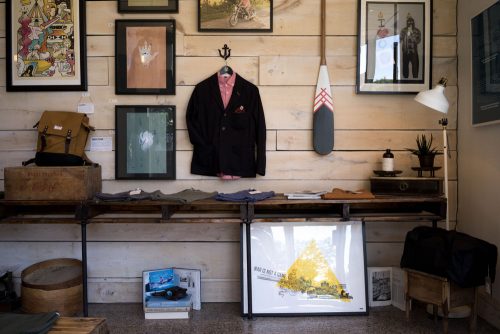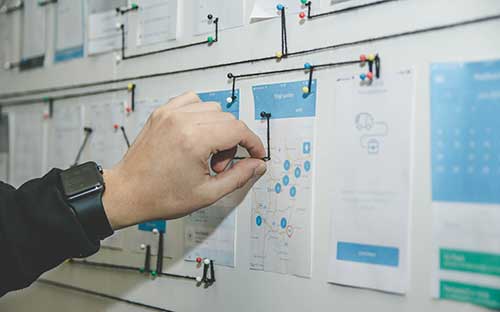
What began as a fun experiment to recreate iconic state-themed sandwiches has grown into a thriving digital brand for Maddy and JD, the couple behind Them Bites. With backgrounds in photojournalism, restaurant management, and SEO, they had the right mix of skills to build something special — but TikTok wasn’t their first choice. It wasn’t until their recipes started gaining traction that they realized the platform’s potential to grow their brand.
Now based in Asheville, the duo juggles full-time jobs with content creation, bringing in over $1,000 a month through the TikTok Creators Rewards Program and occasional sponsorships. Their knack for mixing nostalgia with fun, down-to-earth content has helped them build an audience of 120K+ followers across platforms. What started as a creative outlet has become a blueprint for anyone looking to turn their passion into profit through social media.
Recipe for Growth: How They Built Their Audience
When Maddy and JD first gave TikTok a try, they weren’t impressed. The platform felt chaotic, and the trends seemed impossible to keep up with. But once their videos started gaining traction, they realized TikTok was the perfect place to grow their brand. It offered a way to reach thousands of viewers quickly without needing a big budget, so they decided to go all in. “It quickly became clear that TikTok is by far the best platform for influencers our size,” they said.
Their big breakthrough came from an unexpected spark of inspiration: state sandwiches. JD had the idea while brushing his teeth — simple, but perfect for social media. The series tapped into nostalgia and got people talking, with viewers sharing their opinions and sticking around to see which sandwich would represent their state next.
Their Pepperoni Rolls video, celebrating West Virginia, quickly racked up 3 million views on TikTok, bringing in 10,000 followers almost overnight.
@thembites West Virginia is on to something with these Pepperoni Rolls #westvirginia #pepperonirolls ♬ original sound – Them Bites
On Instagram, the Vermonter sandwich video hit 2.8 million views and fueled a surge of new followers in just a few days.
These viral moments demonstrated to Maddy and JD that success on TikTok isn’t just about luck; it’s about striking the right balance of creativity, simplicity, and consistency. The excitement surrounding their Pepperoni Rolls video on TikTok, combined with the popularity of the Vermonter sandwich video, illustrates how viral content can attract a wave of new followers and create valuable revenue opportunities.
If you’re looking to make money on TikTok, here are some tips to get you started:
- Stay Consistent. Post engaging content to keep your audience interested.
- Leverage Nostalgia. Create content that taps into shared memories to connect with viewers.
- Engage with Your Audience. Respond to comments to build a loyal following.
- Use Trend Analysis Tools. Use keyword tools like Ahrefs to find what’s trending.
- Document Your Ideas. Keep spreadsheets and whiteboards handy to organize your content and ideas.
These tips aren’t just about creating standout content; they also reflect Maddy and JD’s overall strategy for growth. Their success relies heavily on staying organized and planning ahead. By using whiteboards and spreadsheets, they effectively track ideas and manage their content schedule. Additionally, tools like Ahrefs enable them to identify trends and ensure their videos resonate with what viewers are searching for. Working as a team also gives them a unique advantage — when one of them needs a little motivation, the other is always there to help keep things on track.
For Maddy and JD, food content isn’t just about sharing recipes — it’s about creating moments that resonate with people. They make sure their personalities come through in every video, helping viewers feel connected.
“When you tap into people’s memories and make them feel something, they’re more likely to engage,” they said. By mixing storytelling, nostalgia, and smart planning, the couple has built a loyal following across platforms, showing that with the right idea and steady effort, real success is possible.
How Maddy and JD Build Trust with Their Audience
For Maddy and JD, being real with their audience is non-negotiable. Trust isn’t built through fancy edits or following trends — it comes from being genuine and approachable. “We try to stay true to ourselves, whether it’s how we show up on camera or how we respond to comments,” they said. They’ve learned to welcome feedback, even when it’s critical. “You’ll get your fair share of naysayers, but they’re usually not trying to be mean,” JD shared. “It’s important to go easy on your viewers — and on yourself.”
This openness to feedback has helped them build a strong sense of community. Instead of getting defensive, they use comments and messages to improve and engage with their followers in a meaningful way. This back-and-forth connection has been key to growing a loyal audience that actively participates in their videos and spreads the word.
Consistency is also a big part of their approach — not just in posting videos but in how they present themselves across platforms. At first, neither of them wanted to be on camera, but embracing that vulnerability made a huge difference. “Looking back, it’s funny how nervous we were about showing our faces,” JD said. “But it made such a difference in how people connected with us.”
By staying honest, having a sense of humor, and interacting thoughtfully with their audience, Maddy and JD have created a brand that feels approachable and trustworthy. In a world where influencers often aim for perfection, Them Bites stands out by keeping things real and building connections that matter. “When you connect with your viewers on a personal level, they’re more likely to engage and support your work,” JD noted.
Turning Content into Income
Making money online takes strategy, and Maddy and JD have applied the same thoughtful approach to monetization as they do to content creation. Their most consistent income comes from the TikTok Creators Rewards Program, earning $500 or more each month from just four videos.
Maddy and JD also stress the importance of reaching out to brands for collaborations. “Once you start building a following, brands will contact you,” JD explained. “But you can’t just wait around — you have to reach out to them too.”
They’ve landed brand partnerships with companies like Woeber Mustard, Old Westminster, and Explore Asheville — most of which they initiated themselves. “Most of these deals were ones we reached out for ourselves,” JD shared. One of the biggest lessons they’ve learned? Know your worth. “We don’t take free products for sponsored posts — it’s crucial to recognize your worth.”
They carefully evaluate each deal, paying close attention to exclusivity clauses and whitelisting agreements, which can limit future partnerships. “The key is understanding what a brand is looking for and building on that to make the partnership work,” he added.
While TikTok remains their primary revenue stream, Them Bites is about more than just one platform. TikTok helps drive traffic to their blog, where they use tools like Linktree and respond to comments with recipe links to keep followers engaged. Still, JD sees room for improvement. “Honestly, I could do a better job with calls-to-action on the site to get more subscribers,” he admitted.
The blog isn’t monetized yet, but they’re thinking long-term about ways to enhance it and how starting a blog can eventually lead to income. They plan to explore display ads with platforms like Mediavine or Google AdSense, though they’re taking a slow and steady approach. “We’d rather build traffic organically and keep things clean than clutter the site with ads too soon,” JD said. It’s all about finding the right balance between growing revenue and maintaining an enjoyable user experience.
Related: How to Make Money Blogging in 2024 (Expert Guide)
Lessons Learned and Advice for Aspiring Influencers
Building a successful online business hasn’t been easy — it’s taken persistence, planning, and plenty of trial and error. One of the toughest challenges early on was figuring out the rhythm and timing that works for short-form video. “It took time to figure out what worked on TikTok,” JD explained. “We posted over 120 videos before anything really took off.” Deciding whether to dive into long-form video has been another ongoing challenge, but they’ve learned to embrace the trial-and-error nature of content creation.
Getting comfortable on camera was also a hurdle at first. “Neither of us wanted to show our faces — it felt really intimidating,” they admitted. “Looking back, it seems silly, but it made such a big difference. People connect with personalities, not just content.”
Their advice for aspiring influencers is straightforward: focus on building the basics first. “Learning how to shoot and edit video — and understanding good lighting — is essential,” JD said. “If you’re not willing to put in the time, it’s going to be tough to succeed.” They stress that consistency and effort are non-negotiable and encourage newcomers to treat content creation like any other job.
“It’s easy to assume being an influencer is all fun and games, but it’s really like adding one or two extra jobs to your life,” JD said. “You have to enjoy the process, or it’ll start to feel overwhelming.”
They also recommend experimenting with different ideas until something clicks. “Pick a niche and just start creating,” they advised. “Once you’re comfortable, think about a series that will engage people — it’s a great way to build momentum.”
Their story shows that success doesn’t come overnight, but with the right mindset, persistence, and a little creativity, building a profitable online presence is possible.
Closing Thoughts on Building a Side Hustle That Lasts
Maddy and JD’s journey with Them Bites shows that influencer success doesn’t happen overnight — it takes experimentation, persistence, and smart planning. By sticking to their love of food, being intentional about their growth, and making thoughtful business decisions, they’ve built a brand that’s both profitable and sustainable.
Their story is proof that anyone with a niche, some creativity, and the ability to adapt can build something meaningful online. Whether it’s testing different content ideas, using feedback to improve, or balancing partnerships with long-term goals, their experience offers a solid game plan for aspiring influencers and those exploring various side hustle ideas.
As they continue growing Them Bites, they remind us that building something worthwhile takes time and effort. But their biggest advice is to enjoy the process, stay consistent, and most importantly — just start.
Related:
- How This Chef Makes $2,000 per Month with a Food Blog
- 16 Realistic Ways to Make $1,000 Fast
- How to Start a Business in 9 Simple Steps
The post How This Couple Makes $1,000 a Month Cooking on TikTok appeared first on DollarSprout.

It’s been six years since we bought our red Nissan NV200 and turned it into a compact camper van. In that time, we’ve driven our little stealth camper all across the US and Canada, and we’ve also been able to meet a lot of other people in the vanlife community.
There’s one big difference between our setup and most people’s vans, though…
Most vanlifers aim to create a “dream van” — an all-inclusive home on wheels that’s Instagram-worthy inside and out. But without an unlimited budget, this usually means buying a cheap, older van and sinking thousands of dollars (and tons of time) into a complicated camper conversion process.
We opted for the reverse.
Rather than transforming a vintage rust bucket into a palace and hoping the engine doesn’t crap out, we searched for the most reliable van, then splurged on a used model in excellent condition — and skimped on the camper van conversion itself.
We spent $12,300 on a 2013 Nissan NV200 back in 2018 — the most we’d ever paid for a vehicle — and added less than $500 in conversion modifications to make it comfortable for the two things we truly need it for: driving and sleeping. Our travel goals were to live largely out of the van, not secluded away in it.
Spending more to get a van with only 51,000 miles on the odometer and less on renovations allowed us to rack up over 169,000 additional miles and 6 years of memories without ever being left on the side of the road due to mechanical failures.
Here’s how our Nissan NV200 fared, including every expense — from the initial camper van conversion to the repairs along the way — and what we did about the diagnosis from its latest garage visit…
Note: This article includes some affiliate links. If you click one and make a purchase, we’ll get a small commission. 100% of our affiliate profits go to charity, and we never let these affiliate relationships affect our recommendations (learn more).
Our Nissan NV200 Build and Price
Main article: Dirt Cheap Travel with a Nissan NV200 Camper Van
The mods we made to our Nissan NV200 to convert it from compact cargo van to a road-tripping camper van were so simple that they might be called “lazy” — but we’ve honestly been very happy with the results.
We knew we’d need storage space for our first big trip to every National Park in the US, so we built a wooden platform to provide shelving in the cargo area. Then, we threw a full-size mattress on top of it, and that’s about it — for the big stuff, anyway.
Some smaller, helpful additions included hooking a power inverter up to our van’s battery to let us charge all our devices and camera equipment on the go. We also affixed battery-operated tap lights to the storage areas, and hung up a backseat organizer to keep little things handy.
All in all, our Nissan NV200 camper conversion cost us less than $500 and a couple hours to put it all together.
You may have noticed a lack of certain amenities, such as a kitchen or bathroom, but we found that we really didn’t need them. Once you realize that every place you stop has a toilet and that there are several ways to get a hot shower in almost every town, you’ll be glad you don’t have to refill water tanks or deal with your own waste disposal.
We have zero regrets about our minimalist Nissan NV200 camper van build.
(adsbygoogle = window.adsbygoogle || []).push({});
Nissan NV200 Reliability and Problems
Our Nissan NV200 hasn’t just been our travel rig — it’s been our only vehicle for the past 6 years. Needless to say, we’ve put a ton of miles on it, from an odometer reading of 51k at the time we purchased it to nearly 220k today.
So, what Nissan NV200 problems have we run into after covering that much ground? Almost none!
Obviously, we’ve done general maintenance like $30 oil changes every 5,000-6,000 miles and replacing air filters, tires, the battery, and brakes as needed.
We also changed the CVT fluid for the first time around 150,000 miles (although we probably should have done this way sooner ) and again around 190,000 miles. Despite a lot of warnings from mechanics and online forums, the Nissan NV200 CVT never gave us any issues at all.
Right around that 150,000-mile mark though, our AC compressor died, which was especially bad timing since we were about to take off on a cross-country summer road trip. But we simply delayed our trip by a few days, ordered a replacement from Rock Auto, and had a local mechanic put it in for a grand total of just $300 (including parts and labor). The AC was back to icy cold, and we were back on the road.
This year, at around 219,000 miles, our luck finally started to run out. The van was idling pretty rough, pulling to one side, and sometimes taking a little long to start, so we brought it to the shop for a checkup before another summer trip. This time, though, the fix wasn’t gonna be so cheap.
The mechanics convinced us to replace one of the control arms, the ignition coil, and spark plugs, all before they discovered that our rough idle was actually caused by a low-compression engine cylinder — a very expensive problem that just wasn’t worth fixing.
Over the entire lifetime of our Nissan NV200 — from 51,000 to 220,000 miles — we spent a total of just $1,400 on repairs outside of regular maintenance. And the majority of that was wasted money spent right at the end. Mechanically, this van has been rock solid.
Some Minor Nissan NV200 Glitches
Aside from mechanical issues, our Nissan NV200 came with a few tiny annoyances, but in the context of 169,000 miles of driving, they’re pretty forgivable.
For one thing, some of the van’s plastic parts break too easily, like the handle mechanisms inside the sliding side doors. Our exterior left rear door handle broke twice, leaving it openable only from the inside handle, which is much sturdier. If you get in the habit of opening the doors slowly from the outside, you’ll be fine.
A few of the plastic plugs that seal the roof rack holes on top of the van wore out over time, too, which caused minor roof leaks. We sealed them up with super glue from the Dollar Tree, and we were good to go again.
We’ve also had to take the driver door step panels off repeatedly to make adjustments to our aftermarket stereo wiring and to add connections for our power inverter. Unfortunately, those plastic pieces don’t fit back together so snugly anymore.
Our factory-installed on-board navigation system also stopped working properly due to a failing SD card that held the map data. We never replaced it because Google Maps on a smartphone does a better job anyway.
Lastly, it’s worth noting that the Nissan NV200 has strangely tiny tires for its size. When you go to get them replaced, you’ll probably find that “standard” tires of the correct size are available, but it’s recommended to special order “commercial-grade” tires instead, to accommodate the extra weight of a van.
We usually went with the “standard” tires because they’re cheaper and more readily available, but it did seem like we ended up replacing them a little more frequently than we’re used to with other vehicles.
(adsbygoogle = window.adsbygoogle || []).push({});
The Math on How Much Vanlife Can Save You on Travel
A lot of people who get into RVs, vanlife, and camping start out with the idea that it’s a “more affordable” way of travel — and it is — as long as you do it with a minimalist mindset. If you try to build all the comforts of home into your rig, your costs will spiral out of control.
One quick “sanity check” on any camper setup is to compare its total cost against what it would hypothetically cost to just vacation in hotels every single night. Most big RVs completely fail this test, and often vanlifers who stay at paid campsites every night fail this test, too.
Our style of vanlife gets a passing grade because we have no on-board shower or bathroom, freeing us from the need for “hookups” and allowing us to avoid campgrounds and park for free every night instead.
Additionally, we’ve found that the EPA-estimated 26 MPG of the Nissan NV200 has been pretty accurate for us over the years. Most compact cargo vans on the market get similar gas mileage, which is pretty great compared to the abysmal 10-15 MPG offered by bigger rigs like Class B campers and Class C RVs.
You don’t even have to do the math to know that a smaller, more fuel efficient vehicle will save a ton of money on long road trips.
(adsbygoogle = window.adsbygoogle || []).push({});
Nissan NV200 Camper Van: Would We Do It Again?
When our 2013 Nissan NV200 started dying this summer, we didn’t hesitate to snap up a newer model from Facebook Marketplace. After a few days of searching, we found a white 2021 Nissan NV200 in great condition with about 100,000 miles on it.
We had to drive a couple hours to pick it up, and it cost us $14,000 — setting the record for our most expensive vehicle of all time — but given how well our last Nissan NV200 camper van aged, we were just happy to be able to get back to our version of vanlife.
Once we got it home, all we had to do was move our platform, bed, and small accessories over to the new van, and we were ready for our next road trip in a matter of minutes.
Oh, and just in case you’re wondering what became of our old NV200: We sold it on Craigslist for $4,000 cash — not bad for a dying van with 220k miles! It seems like the Nissan NV200 holds its value better than most cars (though it’s certainly still a depreciating asset, like any vehicle ).
— Lauren
The post Our Nissan NV200 Camper Van Conversion (220k Miles Later!) appeared first on Trip Of A Lifestyle.

If you’re in the market for a used car, the last thing you want to do is spend your hard-earned money on a vehicle that turns out to be a lemon. While most states have “lemon laws” to help protect consumers who purchase defective vehicles (more on that below), in many cases, you must have […]
The post Used car buying tips from a mechanic: How to buy a secondhand car without getting ripped off appeared first on Wealthysinglemommy.com.

In a previous article, I mentioned the benefits to owning a Fidelity Credit Card. Well my faithful audience, let me tell you about another card that will help you on your investing journey. If you are new to investing or are experienced, using a credit card that helps you invest is a must. The Robinhood Gold Card gives you 3% cash back on all purchases. I mean, come on, you are going to spend the money anyways, might as well get rewarded for it. I use my credit card for all my purchases. At the end of the month I get rewarded with free cash that I use to help me invest. As an added benefit, you can signup with my link and earn up-to $200 in free stocks. To get started, signup here to create an account on RobinHood.

The retirement crisis: How did we get here?
Despite modest improvements in the retirement savings landscape, millions of Americans remain dangerously underprepared for their golden years. With 28% of people having no retirement savings and nearly a third of working Americans holding less than $1,000, the reality is clear: financial insecurity is looming large, especially for older adults on the brink of retirement.
Retirement in America is in crisis
As of 2024, the state of retirement savings in the U.S. has shown some improvement—if you squint hard enough. But let’s be real: many Americans are still tiptoeing toward their golden years with empty pockets. According to a recent Yahoo Finance report, 28% of Americans have precisely $0 saved for retirement. That’s right—zilch, nada, not even a rainy-day penny under the mattress. Meanwhile, 30% of working folks have managed to scrape together a whopping $1,000 or less, which might get them through a luxurious weekend of ramen and Netflix.
And it gets worse. Among people aged 65 and older—the very demographic that should be kicking back with a piña colada on some tropical beach—about 14% have saved less than $1,000 for their entire retirement. If you thought Social Security was going to swoop in and save the day, grab that cup of ramen because it will be a long ride.
Now, while some of these numbers may have improved slightly since the last decade, the reality is that many Americans are still woefully unprepared for retirement. 46% of households at least have some savings squirreled away, but let’s not break out the champagne just yet. The gap between those who are prepared to retire in comfort and those who will struggle to make ends meet is widening as healthcare costs rise faster than Beyoncé ticket prices.
So, what’s going on? Why can’t Americans save for retirement?
Are Americans financially reckless? Absolutely not. Most people are smart enough to know that, unless they plan to live off their cousin’s couch, they’ll need some cash when they stop working. The problem, as always, is more nuanced than that.
It’s likely one of two things, or both: Americans simply can’t afford to save or are too caught up in today’s expenses to focus on tomorrow’s needs. And let’s be honest, with inflation turning grocery shopping into a game of “What can I live without?” it’s no wonder people are choosing to live in the present. It’s hard to think about your 75-year-old self when your 35-year-old self is stressing over this month’s rent and that student loan bill you’ve been side-eyeing for years.
Yahoo Finances’ and other findings aren’t exactly earth-shattering—after all, we’ve been hearing the same tune for years. Every few months, a new university or think tank study reminds us that Americans are falling behind on retirement savings. And while it’s tempting to believe that people are just ignoring the warnings, the truth is much more complex. Between stagnant wages, the high cost of living, and the unpredictable economy, saving for retirement feels less like a prudent financial goal and more like wishful thinking.
It’s not that Americans don’t want to save for retirement. Most do. However, whether due to immediate financial pressures, the simple fact that tomorrow feels very far away (see hyperbolic discounting), or that wages have been virtually stagnant since the 1970s, many people just can’t prioritize it.
Americans can’t save for retirement
One of the most plausible reasons Americans aren’t saving enough for retirement is that they simply can’t afford to.
The average American wage, particularly for middle- and lower-income earners, has remained largely stagnant since the 1970s. While it may seem like wages have gone up at first glance, the devil is in the details. For instance, the median household income in 1984 was $22,415; by 2014, it had risen to $53,891—a 140% increase. But here’s where things get tricky: inflation, skyrocketing living costs, and the fact that more households rely on dual incomes muddy that seemingly positive statistic.
The 2-income trap
In 1984, 60% of mothers with children under 18 were in the workforce; by 2012, that number had jumped to 71%. More earners in the house should mean more money to go around, right? In theory, yes. The increased cost of living has devoured these dual incomes like a hungry teenager at an all-you-can-eat buffet. This isn’t to shame working moms or households where both parents work. It’s just the financial effect of the culture change.
Housing costs: A towering obstacle
Consider the cost of housing. In July 1984, the median price for a new home was $80,700 per the US Census. Fast forward to today, and that price has ballooned by 431%, with the median home now costing $428,096, according to Redfin. For many, buying a home has become less of a rite of passage and more of an Olympic sport, with the finish line always just out of reach.
The cost of just getting around
Then there’s the cost of transportation. According to the Chicago Tribune, in 1984, owning a car cost about $5,000 a year. AAA says today’s cost has surged to $9,282 annually—an 86% increase. So, while your car may now come with heated seats and a backup camera, it’s also burning a bigger hole in your wallet.
College costs: They’ll make you cry
Education is another area where costs have gone off the rails. Sending a student to a four-year public college in-state costs around $24,513 annually per U.S. News & World Report. That’s a 437% increase from $4,563 (National Center for Education & Statistics) in 1984, when it was a much more digestible figure. That’s enough to make anyone reconsider those extra courses in underwater basket weaving.
Healthcare or medical debt scare?
The real kicker, though, is healthcare costs. In 1984, according to the National Institute of Health, most families paid a modest $1,580 yearly for their health insurance. Today? Families are forking $7,620 annually, per Forbes – a 382% increase. And that’s before you even get to the co-pays, deductibles, and random bills for “facility fees” (whatever those are).
Eggs: Even chickens are charging more
Here’s a contentious topic during the Trump/COVID/Biden/Harris era. Even the cost of everyday staples has spiked. Eggs cost about $1.30 per dozen in 1984. Today, per SoFi, eggs are averaging $3.00—a 131% increase. Sure, that might not seem like much, but every penny counts when you’re cracking eggs into your retirement plans.
The Bigger Picture: Americans Are Drowning in Costs
These figures paint a pretty clear picture: the cost of living has far outpaced wage growth. For many Americans, the dream of retirement savings is less of a “pipe dream” and more of a luxury only a few can afford. Between housing, healthcare, transportation, and everyday necessities, the average American is just trying to keep their head above water, let alone build a retirement fund.
In a world where 46% of Americans have some savings for retirement (USA Facts), the gap between those who can and those who can’t save for their future is growing. So, the next time someone says, “Why don’t Americans just save more for retirement?” feel free to toss out these numbers, along with a side of expensive eggs, for a little perspective.
American’s carpe diem thinking
Another reason many Americans may be sidelining their retirement plans is that they are too caught up in the pleasures and demands of the present. After all, when the allure of immediate gratification is this strong, who wants to think about something as distant and unexciting as retirement? Americans are spending more than ever on necessities and luxuries we now view as essentials.
A snapshot of spending habits
Take a look at some eye-popping stats:
- Home sizes have ballooned, with the average home size increasing from 1,605 square feet in 1984 to 2,140 square feet in 2024, per the U.S. Census Bureau. Every American now needs an extra 1,000 square feet to store all the stuff we’re buying.
- The cost of watching TV has also exploded. Today’s families are shelling out anywhere from $90 to $120 per month for TV, streaming, and internet bundles, compared to my dad’s grumbling about his $12 cable bill back in the day, including HBO; thank you very much! Now, HBO alone will set you back around $10 – $20 a month.
- Then there’s eating out. A plurality of Americans now eat out at restaurants once a week or more (Statista.com). That’s a lot of Taco Tuesdays, which may explain why saving for future Taco Tuesdays in retirement seems less of a priority.
The price of convenience and luxury
What do these trends tell us? The cost of just about everything we “need” or think we need has skyrocketed. And it’s not just the obvious big-ticket items like housing and cars. Consider all the modern “essentials” we didn’t even have in 1984—smartphones, high-speed internet, personal computers, and the dreaded $8 daily coffee habit. These are now considered non-negotiable staples of daily life. Add in the constant pressure to upgrade, refresh, and stay trendy, and it’s no wonder people are more focused on financing today than worrying about tomorrow.
In a sense, many Americans are playing the role of the grasshopper from Aesop’s fable, living it up today and figuring they’ll deal with winter (retirement) when it comes. After all, “Why bother about winter? We have plenty of food at present,” as the grasshopper famously said before learning the hard way that winter waits for no one.
A million bucks isn’t enough anymore
To make matters worse, even those who manage to scrape together a nest egg may find that $1 million in retirement savings—once seen as a surefire ticket to comfort—is now barely enough to maintain a middle-class lifestyle for 20 or 30 years. With inflation chipping away at the value of every dollar, retirees today need more than ever just to cover the basics, let alone live the “fabulous retirement” they’ve been dreaming of.
Why retirement insecurity isn’t your fault
While it’s easy to wag a finger at Americans for their lack of retirement savings, the reality is far more complicated than just bad spending habits or financial ignorance. Much of this mess stems from factors beyond individual control—an economic system engineered to encourage spending now and worrying about tomorrow later.
We live in a consumption-driven economy where corporate greed and political sleight of hand have shaped financial priorities. Companies have perfected the art of making sure we focus on immediate gratification, whether it’s the latest iPhone, a new streaming service, or, yes, the urge to DoorDash sushi at midnight. This “buy now, think later” culture has created an environment where retirement planning feels as thrilling as watching paint dry.
Even worse, political policies have often sided with corporations, favoring short-term profits over long-term security for the average citizen. The transition from pension plans to 401(k)s in the late 20th century is a perfect example. By passing the responsibility for retirement savings from employers to individuals, companies neatly sidestepped one of their largest financial obligations. Meanwhile, Wall Street gleefully swooped in to collect fees, leaving individuals with the stressful burden of navigating retirement planning solo.
And let’s be real: it’s hard to save for the future when you’re still figuring out how to pay for the present. Wages have remained stagnant while living costs have skyrocketed, making retirement savings more of a luxury than a necessity. As the saying goes, you can’t pour from an empty cup—and Americans’ cups are often bone-dry.
Then there’s hedonic adaptation, our natural tendency to get used to new luxuries and quickly want more. Remember when a cell phone was a luxury? Now, it’s basically oxygen. We used to be thrilled with basic cable; now, we can’t live without subscriptions to Netflix, Hulu, HBO Max, and Disney+. Each year, our definition of “normal” keeps upgrading—bigger homes, more innovative gadgets, and better shoes (because clearly, one needs 20 pairs even if they only wear five).
And let’s not overlook the impact of the COVID-19 pandemic. The stress cycles Americans have been stuck in since 2020 have only deepened the problem. Between job instability, economic uncertainty, and the pressure to stay connected in isolation, many turned to “comfort spending” to cope. A survey by Northwestern Mutual found that nearly a third of Americans reported splurging on non-essential items during the pandemic as a form of stress relief. That $15 daily latte might be a financial crime to future you, but to present you, it’s an act of self-care.
So, can we really blame Americans for choosing the here and now over some far-off, fuzzy concept of retirement? Not entirely. The truth is: the game is rigged. Between corporate manipulation, political policies, and human psychology, the system isn’t designed to help people save. It’s built to make us spend and spend again until one day, we wake up and wonder, “Wait, where did all my money go?”
To fix the retirement crisis, we need more than just scolding about saving more. We need a systemic overhaul—one that rebalances our economy to support long-term financial stability over short-term corporate greed. Until then, the average American is just trying to stay afloat in a sea of rising costs and shrinking paychecks.
So, meanwhile, . . .
Balancing living today with retiring tomorrow
Remember, deep down inside, most of us want The Four Freedoms: 1) Financial, 2) Relationship, 3) Location, and 4) Time.
So what’s the solution? Americans must rethink the balance between enjoying the present and preparing for the future. Here are a few steps that can help:
- Automate Your Savings: Automate your savings by eliminating the need to think about saving. Setting up automatic contributions to your retirement account ensures you’re building toward the future, even when you’re focused on today.
- Reassess “Essentials”: Do you need 20 pairs of shoes? A quick audit of your spending habits may reveal opportunities to cut back on luxuries and redirect those funds toward your retirement goals.
- Start Small, Start Now: Even if you feel behind, it’s never too late to start saving. A little can grow into a lot with compound interest, especially if you begin early.
- Set Realistic Expectations: Retirement may not look like a never-ending vacation on a tropical island, but with careful planning, you can still maintain a comfortable lifestyle.
- Seek Professional Help: If you’re overwhelmed, financial advisors can help you create a personalized plan that fits your current situation and future goals.
At the end of the day, balancing today’s joys with tomorrow’s needs is a challenge many of us face. But with a little planning and discipline, it’s possible to have both—the fun and the future security.
Get some help with your retirement:
- 3 Things You’re Forgetting to Plan for in Retirement
- Your Sure FIRE 5-Step Early Retirement Plan
- How to Retire? 65 Tips for Financial Planning for Retirement

Honestly, we all need more winter dinner ideas for those cold nights. Get ready for some new comfort food recipes! To be honest, I’m not the biggest fan of winter weather. But these meals are something to look forward to on those cold, short days. As a busy Mom, I really only have the patience […]
The post Winter Dinner Ideas: Meals That Will Keep You Cozy and Warm appeared first on Medium Sized Family.

As I write this, the Biden Administration has extended the payment pause on borrowers enrolled in the SAVE plan for another 6 months.
Might I offer a suggestion: take that money and put it into a rainy day fund or invest it in an index fund (VTSAX) or individual stocks (The Trillion-Dollar Club such as MSFT or META).
Now that I have offered my savings and investment advice, let’s talk about how I got to my first $400K.
They say the first $100K is the hardest. I remember from years ago a time when Drake tweeted that. Don’t remember? That’s cool. I have a copy of his tweet for you to see below.
Well, my money target was higher since I figured I’d go big or go home.
I made my target $400K.
I totally borrowed that title from Her First 100K blog, but I am sure Tori Dunlap will not mind if I borrow it if it helps motivate people to become financial independent.
Although I have a six-figure compensation package now (salary + benefits), it did not start off that way.
You will not believe some of the jobs I have had on my path to becoming a self-made woman millionaire. Let me share 4 of them with you here.
1. Waitress ($2.65 per hour + tips) – Back when I was still in high school I did a summer job as a teenage waitress at Shoney’s. It wasn’t glamourous, but the tips were pretty good. Some days I could clear $50-$100 bucks a night! That’s some good money to a teenager. And the menu there was huge. There was no way I could remember it all. I mean who do they think I am. Sheldon Cooper. I do not have a photographic memory. However, lucky for me, this restaurant had a buffet so it basically sold itself. I was mostly there to bring drinks and the check. It was physically demanding though as it required you to stand virtually all-day. I did get 50% off any food I wanted and the cooks in the back were great. This is my foundation on what it takes to earn a $1. Like Britney Spears says, “work b*tch!”
2. File Clerk/Loan Analyst ($28,000/year) – I was still working my way through college when I got this job. I answered an ad and went in for an on-the-spot job interview and got the job! Essentially, I helped maintain loan documents and helped manage bank customer accounts at a credit union. This job would set me up for what was to come, which was my foray into lending and finance.
3. Night Auditor ($20 an hour + tips) – This was another job I got from answering an ad on Indeed. They were offering $18 but I negotiated $20. Never underestimate the power of negotiation ladies! And the funny thing is when I actually started doing the job, I did so much work that I really should have been making $25 at least! You have answer phones, check-in guests, keep the hotel lobby clean, manage guest complaints and do point-of-sale transactions for the hotel market by the front desk. Then there was the lounge at the hotel that was a mini nightclub that was open until 2am! We did have a few celebrities come through, but I mostly just stayed at the front desk. And did I mention I worked overnight from 11pm – 7am! However, it was fun overall because I had a great coworker. I even had a guest tip me $100 for calling him a cab. Sweet!
4. Associate Director (over $80,000k+/ year) – After college, I applied for another job in lending. Basically, counseling families on how to navigate the financial minefield that is financial aid. I also completed two Master’s degrees and started this blog on the side while doing my job. This blog is my side hustle and it did start to generate some income eventually. However, when asked by Business Insider for the article they published on me, I declined to go into details.
All these jobs helped put me on the path to where I am today, which is female millionaire.
Every time I earned more, I invested more.
I started with a fistful of dollars and turned a small $5,000 investment in Apple into an investment portfolio over $400,000!
The next leg of the journey is $500,000.

Image Credit The freelance economy has exploded in recent years, offering individuals the flexibility to pursue their passions and work on their own terms. Whether you’re a writer, designer, developer, or consultant, freelancing provides the opportunity to be your own boss and set your schedule. However, with great freedom comes great responsibility. Without a structured environment or a steady paycheck,…
The post Top Tips For Success As A Freelancer appeared first on Cash for Kat.

It’s finally starting to cool off and feel like fall here! Aside from being soup and sweater season, another lovely thing about fall is that utility costs are lower because you don’t have to pay to to cool or heat your house. Stretching this low utility cost season even further is one of our number one strategies for keeping our expenses down.
Let me start by sharing a classic analogy that illustrates what I’m talking about. I’m sure you’ve heard the story before, but you probably haven’t thought about it in relation to your gas or electric bill.
It is said that if you drop a frog into a pot of boiling water, he’ll immediately jump right out. But, if you drop the frog into comfortable water, then gradually heat the water to boiling, the frog will be toast (well, boiled).
I can picture this frog-in-the-pot scenario happening, but husband Mike thinks it would never actually happen. Either way, we’re too nice to test it out.
Whether or not the frog story is accurate, most of us would agree that gradual, subtle changes are more easily accepted than sudden, drastic changes.
I want to use the principle of the frog analogy (in the reverse) to explain how we save on heating costs.
When people hear how low we keep our thermostat during the winter they think we’re nuts! They can’t imagine changing their home thermostat from 78 degrees down to 58 degrees in the middle of January.
Neither can I! Like a frog placed in boiling water, I would hop right out!
Our secret to saving on heating bills is that we wait as long as possible to turn our heater on or light a fire in the wood stove.
Like the frog who gradually gets used to increased temperatures, our bodies gradually acclimate to a lower temperature.
In addition to normal acclimation, we dress appropriately to increase our temperature stamina. We wear sweaters and slippers around the house. In the morning, I always put a warm robe on over my pajamas when I first get up. In the evenings, you’ll find me quilting, reading, or working on the computer wearing a hoodie on with the hood on.
Our kids all have their own robes and slippers along with hoodies. We have fuzzy blankets and warm quilts in nearly every room.
Lest you worry that our kids are suffering, the truth is that our kids handle the cold (and heat) far better than us grown-ups (especially me). When we lived in my in-laws basement while we were paying off six figures of student loans, our kids would run around the cold cement floors with bare feet and and short sleeves. It didn’t even faze them.
We love challenges and competitions, so seeing how long we can go before turning on the heat (or having our first fire in the wood stove) is actually fun for us. (Maybe we are crazy.) When we eventually do turn on the heat, we don’t crank it up to 78. We just turn it up a wee bit from the temperature that we decided was just too low. If the temperature starts to dip to that point, the heater kicks in and we’re fine.
Of course waiting to turn on your heat isn’t our only strategy for saving on utilities in the winter. Here are eight additional strategies that help us keep our utility expenses down in the winter.
- Dressing warm when you’re inside means you don’t need to heat the air as much to be comfortable.
- Using these window insulation kits is a great way to prevent losing heat to drafty windows. We have found these to make a huge difference in our bedrooms.
- Consider using a space heater instead of central heat if you’re only using a small area in your house (like if you work from home and spend the entire day alone in one room),
- A draft-stopper like this or this will help from losing heat to the outside or colder areas of the house. Rolling up a towel, isn’t quite as convenient as either of those products, but it’s a free option that does the trick pretty well.
- Only heat the areas you use. Close the heating vents in unused rooms in your house (guest bedrooms, storage areas, unused basements, etc). Use the draft-stoppers linked above to prevent those closed off rooms from sharing air with parts of the house you’re heating.
- While leaving curtains open during the day can warm your house with the sunshine, close your curtains at night to provide an additional buffer from the cool outside air.
- Run your ceiling fans in reverse to push the warm air down. This is especially important if you have high ceilings since the warm air will accumulate high up. There is usually a little switch near where the fan meets the ceiling to reverse the fan’s direction.
- Having layers of bedding to create air pockets can keep you toasty enough to turn the heater down significantly. One of my readers who lives in a frigid area shared an awesome guest post several years ago where she taught her smart strategy for bedding layers. I was blown away by what a huge difference this has made!
No matter what efficiency strategies you employ, waiting as long as possible to turn on the heat and keeping the thermostat low when you do will increase your savings. Each day you wait to turn on the heat will save you money and provide a fun challenge as well.
How about you?
- How long do you wait before turning on the heat when the weather cools off?
- Do you dress warmly at home in order to keep the thermostat set low?
- Do you think the frog would really get boiled?
This freshly updated post was originally published ten years ago in October 2014.
Related Posts
The post Our Secret for Saving on Heating Bills (+ 8 More Money-Saving Strategies) appeared first on Six Figures Under.

Saving money can feel overwhelming at times, but even the smallest shifts in mindset can lead to big changes. Whether you’re just starting your savings journey or looking to boost your current habits, a little motivation goes a long way. That’s where these powerful money-saving quotes come in! They’ll inspire you to take control of … Read more
The post 19 Money Saving Quotes to Supercharge Your Savings Goals appeared first on Boost My Budget.
